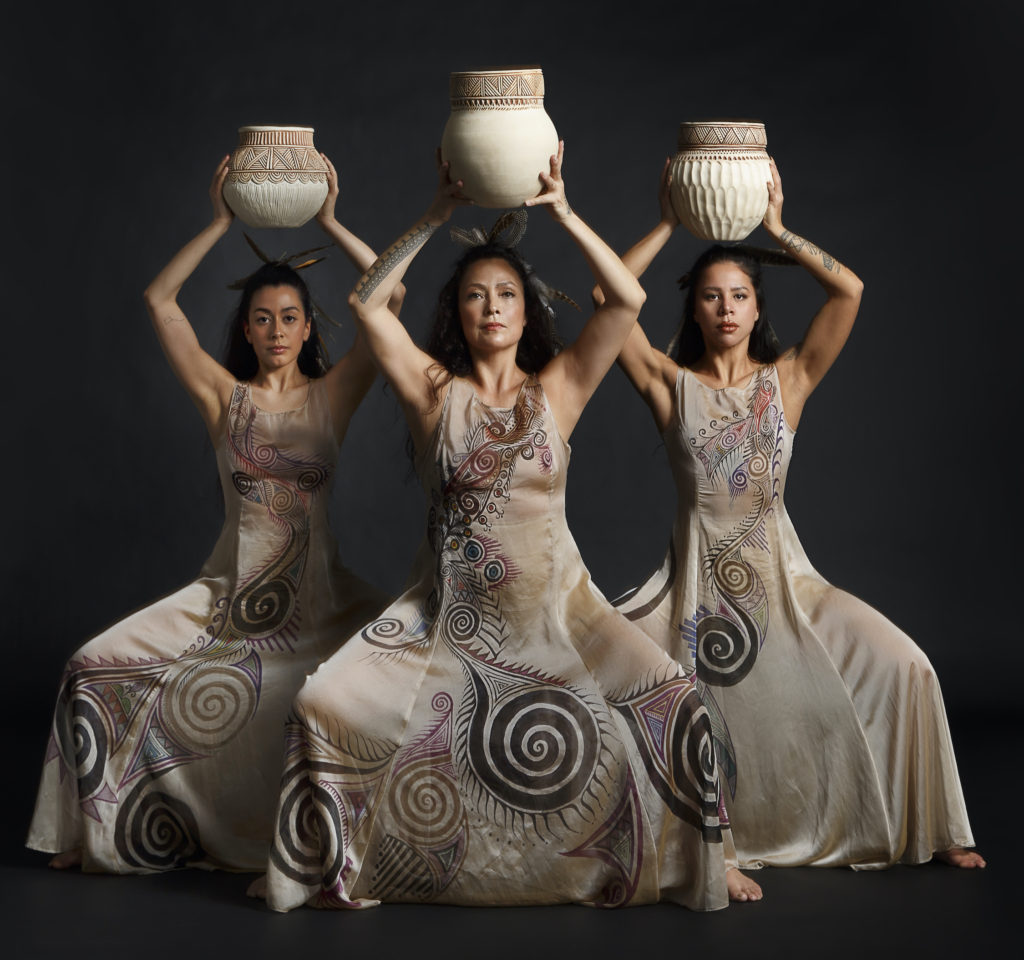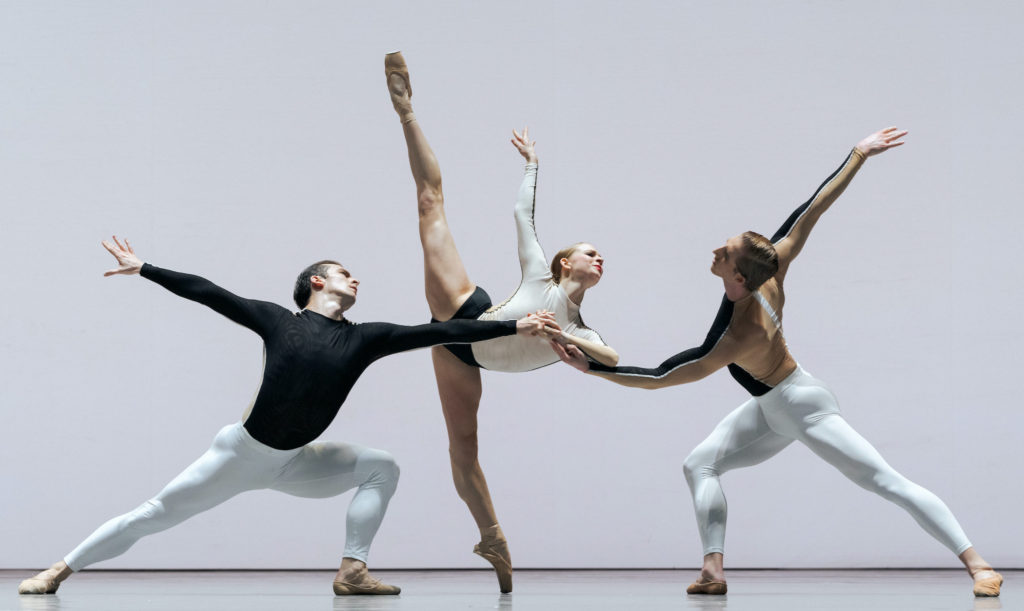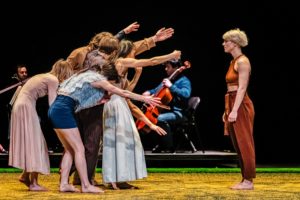Toronto on a Roll: From Throwdown Collective to Evelyn Hart’s boozy Stepmother - Vancouver Ballet Society
- Home
- City Reports 2020 - 2023
- Toronto on a Roll: From Throwdown Collective to Evelyn Hart’s boozy Stepmother

By Michael Crabb
Revolving stages, originally introduced to effect speedy scene changes, have been a popular mechanical device in the theatre for more than a century. It did not take long for directors to discover they could also be used to create a variety of visual illusions such as that of an actor seemingly walking or running yet, from the audience’s perspective, remaining in place. Zhenya Cerneacov, Mairéad Filgate, and Brodie Stevenson, who since 2009 have been collaborating on a series of physical theatre projects as Throwdown Collective, pushed this potential into metaphorical territory in their latest work, Liminal.
Their “revolve” — shorthand for revolving stage — was set within a square platform positioned with one corner directly pointing at the audience so that it looked more like a diamond. The rotational speed ranged from barely perceptible to so fast that the dancers had to lean steeply inward to avoid being flung off.

The intention of Liminal was to explore just how slippery, according to the vantage point, our perceptions of reality and time can be. With constantly shifting views, quite simple situations, such as an embrace, morphed unsettlingly from affectionate to aggressive. As the revolve gained speed, a pleasant stroll became a desperate race against time itself.
Throwdown Collective has built its reputation on amusing, family-friendly works, often performed outdoors as part of Dusk Dances. With the evening-length Liminal, presented at the Theatre Centre, the trio, while not abandoning its accessible persona, is exploring deeper veins of meaning.
Choreographer Virginie Brunelle’s Les corps avalés is also laden with metaphor, most based in movement but some in physical objects, in this instance rolls of artificial turf, hurled around or piled into a mound. They could be an allusion to environmental degradation, just one of the existential issues touched on in this powerful portrait of humanity adrift, or, as the title has it, of “bodies swallowed.”

Montreal-based Brunelle is an intensely musical choreographer. The score of modern contemporary classical composers, played live onstage by the Molinari Quartet with the digital mediation of composer Ben Shemie, is in constant conversation with the dancers, both driving and responding to their sometimes fraught, other times tender gestures. This is humanity lost in a mad, mad world yet determined to cling on in the hope of something better.
Les corps avalés was originally scheduled as part of Harbourfront Centre’s 2019-2020 Torque series of contemporary dance but like so many live performances, its Toronto debut was postponed because of the pandemic. Les corps avalés was more than worth the wait.
For a dance programmer such as Harbourfront Centre’s Nathalie Bonjour, the pandemic made booking artists from abroad more than usually complicated. At the same time, it created openings for those closer to hand. Thus, Mohawk choreographer Santee Smith’s long-delayed new work, Homelands, found a suitable home as part of Bonjour’s Torque series.

Smith lives on the Six Nations of the Grand River reserve, about 120 kilometres west of Toronto. However, the homelands her hour-long work refers to are those of her ancestors, who, having remained loyal to the British, were driven from the Mohawk Valley in the United States at the end of the American War of Independence. The Six Nations reserve is but a small fraction of the tract of land along the Grand River promised by the Haldimand Declaration of 1784.
Homelands is multi-layered, referencing past, present, and future through scenes that mirror the passage of the seasons. At times almost surreal in tone and with elements drawn from Indigenous lore and ritual, Homelands is a meditation on the spiritual bond that connects First Nations to the land, to Mother Earth. The power and agency of women runs through the work as a dominant theme. Choreographed as a trio for Smith and two considerably younger dancers, Feryn King and Katie Couchie, Homelands is performed behind a scrim onto which are projected an evolving stream of evocative images that create a parallel layer of meaning.
Winter season visitors to Toronto, again taking advantage of a post-pandemic return to almost normal life, included the welcome return of Alvin Ailey American Dance Theater, the Toronto debut of Wen Wei Wang’s Ballet Edmonton, a world-tour stop by choreographer/dancer/director Gregory Maqoma and Broken Chord, his stirring indictment in song and movement of racial prejudice, and Australian choreographer Stephanie Lake’s Colossus with its locally recruited student cast performing an ultimately vacuous display of synchronized movement.

As for the National Ballet of Canada, always the big game in town, the highlight of the company’s March season was the Canadian choreographic debut of British-born David Dawson with Anima Animus, made in 2018 for San Francisco Ballet. The title derives from Jungian archetypal concepts of male/female duality, but as the work unfolds, one is less struck by this inspiring idea than by the cool verve of the choreography, full of back-breaking lifts and complex partnering. Cast for six women and four men, Anima Animus tends to put the former in the driver’s seat with the men as obliging porteurs.
Dawson’s choreography very much reflects the mood and spirit of Italian composer Ezio Bosso’s 2017 Violin Concerto No. 1, “Esoconcerto,” with National Ballet Orchestra concertmaster Aaron Schwebel as the soloist. John Otto’s stark black and white set features a cyclorama that — depending on James Ingalls’ lighting — at times casts the dancers in semi-silhouette, present but not quite present.

To fill seats during March break, the company also revived former artistic director James Kudelka’s appealingly unconventional version of Prokofiev’s Cinderella. Opening night honours went to principal dancer Genevieve Penn Nabity and corps member Larkin Miller. Kudelka first brought the two young artists together during the December 2022 run of his Nutcracker and the natural chemistry of their partnership then evident was more than confirmed in Cinderella. Even so, it was veteran ballerina Evelyn Hart who predictably stole the show in a guest appearance as the booze-swilling Stepmother. In later performances, Hart also appeared as the Fairy Godmother.
Could this be the start of a whole new late-career chapter for Hart as a character dancer? Judging by audience enthusiasm, it would be a welcome development.

